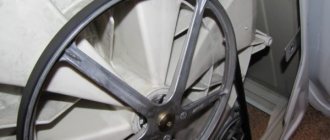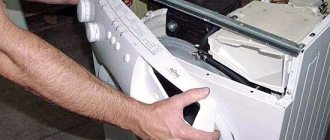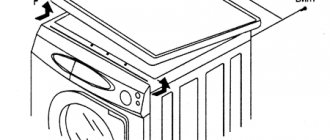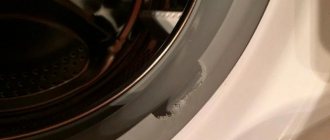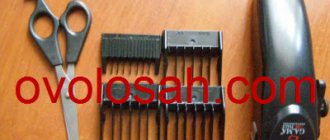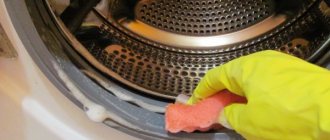During the operation of the washing machine, various technical problems may occur. Among the malfunctions of the home assistant, one can note the appearance of a hum during washing and strong vibration. The cause of serious malfunctions in the operation of a household appliance is defects in the drum. It is possible that it jams and does not spin if foreign objects get into the device components. Replacement of worn-out parts and structural elements is impossible without disassembling the device. To troubleshoot problems, you can use the services of professional technicians and try to solve the problem yourself. Let's look at how to disassemble a washing machine drum yourself and what you will need for this.
Causes of breakdowns
The situation when, after starting the washing machine, after some time it stopped rotating and the drum jammed, is familiar to many owners of household appliances. The reasons for the failure of a household unit may be related to mechanical damage, wear of parts, structural components, malfunctions of electronics, and problems with wiring. To eliminate the malfunction, it is very important to establish the root cause of what exactly caused the malfunction of the household device, and for this the device will have to be disassembled.
Reasons that led to drum failure:
- ingress of foreign objects into components, structural parts, drums - buttons, coins, underwires from women's bras. The drum is jammed, does not spin, and turns with difficulty. To establish the causes of malfunctions, it is necessary to dismantle the heating element, after which third-party objects can be removed;
- jamming, wear of bearings, flanges, seals. The problem arises with frequent use of household cleaning products. The cuff wears out over time and water leaks into the bearings. The bearings fall apart, the drum shaft jams, and the drum does not spin. It is best to entrust replacement to washing machine service specialists;
- broken drive belt, which is equipped with machines with commutator motors. The problem occurs when automatic washing machines are idle for a long time. The belt material loses its properties, cracks appear on its surface, which lead to rupture during operation of the machine. In this case, the most vulnerable spot is the electric motor pulley. Before replacing the belt, remove the back cover of the unit and examine the markings on its outer surface;
- The drum drive motor is not functioning. During operation, the operation of the motor wears off the material of the brushes, and an unpleasant specific smell appears when the washing machine operates. If the brush life is exhausted, the drum stops rotating. Before installing new brushes of the appropriate size, the commutator is cleaned;
- malfunction of the electronic programmer module, which, depending on the model modification, is responsible for the water supply valve, operation of the drain pump, collector motor, thermistor, timer. In fact, the electronic module is responsible for the performance of the main parts and engine components of washing machines.
The drum may jam and not spin if the tachometer fails, the electrical wiring is damaged, or the capacitor burns out. In this case, it is necessary to carry out serious diagnostics. The reason why the drum does not spin may be overload with laundry or clogged filter. All of the above reasons require troubleshooting, so you cannot do without disassembling the washing machine and removing the drum.
Inoperative state of the electronic module
Foreign object in drum
Belt break
Bearing wear
Drum motor malfunction
Tools for work
Before carrying out work, having established the cause of the malfunction, you need to prepare the necessary equipment, tools, and purchase failed elements and parts.
To repair a washing machine you will need:
- screwdriver;
- set of hexagons;
- screwdrivers with a cross-shaped, slotted nozzle;
- open-end wrenches;
- set of sockets, ratchet;
- hammer, pliers.
What may be required for work
In order not to be distracted from the work process, it is worth preparing the necessary tools and purchasing replacement parts in advance. The complexity of disassembly depends on the design of the washing machine model.
Before carrying out repairs, read the operating instructions, familiarize yourself with the technical characteristics, disassembly diagram of the model, watch training videos on disassembling the tank.
Repair of SMA "Indesit": preparatory work
Before changing the drum bearing or performing other work related to disassembling the tank, you will have to completely disassemble the machine. Therefore, make room in advance for such a large-scale work. It is best to do this in a garage or other non-residential premises. As a last resort, the kitchen will do, just keep in mind that the equipment needs to be moved to the center of the room so that it is convenient to get to any panel.
You will also need the following tools:
- a set of slotted and Phillips screwdrivers;
- socket wrenches;
- hammer;
- pliers;
- hexagon;
- drill;
- hacksaw for metal.
Additionally, prepare glue-sealant, rags and water containers. Although the washing machine is disconnected from the water supply, water remains in the hoses and pipes. Do not rush to buy replacement parts in advance; it is better to take out the old elements and go to the store with them. So you definitely won’t go wrong with your choice.
Proceed to the next step.
Disassembling the drum of different types of washing machines
Each type of washing machine has its own specific disassembly and repair work.
Front loading type
Disassembling the drum in washing machines depends on the type of load. Before carrying out any work, be sure to disconnect the unit from the power supply, remove the water supply hoses and drain pipe.
General diagram of the design of front-type washing machines
The work is carried out following the established sequence:
- Use a screwdriver to unscrew the screws securing the rear panel of the unit. Having unscrewed the fasteners, remove the top cover, the front panel along with the hatch for loading laundry;
- dismantle the powder loading container. Use a screwdriver with a slotted head to disconnect the control panel so that it does not interfere with the disassembly of the drum in the future;
- remove the hatch cuff by carefully pulling the clamp spring. Disconnect the bottom panel by unscrewing all the screws located on it;
- shock absorbers, electronics, pipes, and other elements are disconnected from the loading tank. Turn off the motor located behind the drum.
After replacing faulty components, the elements of the washing machine are assembled in the reverse order.
Removing the washing machine cuff
Removing the panel
The front panel can be carefully removed
How to remove the pressure switch Unscrewing the washing machine pulley bolt
Remove shock absorbers and bolts
Remove the tank from the springs
Top loading
The top-loading device is functional, has compact dimensions, and an ergonomic design. Such models are ideal for small bathrooms and kitchens. A design feature of such devices is the location of the hatch in the upper part of the unit, the drum is secured with screws.
Sequence of disassembly work:
- unscrew the screws securing the back cover, the lower front part;
- moving the side panel to the side, remove it from the washing machine;
- remove the electrical wiring, disconnecting the wires, unscrew the bolts around the plastic cover;
- Unscrew the screws securing the shaft and remove the loading tank.
The assembly of the structure is carried out in the reverse order. To avoid mistakes, it is recommended to photograph the most difficult moments during disassembly.
How to prepare an Indesit machine for disassembly?
One of the stages of the drum dismantling process is preparing the Indesit washing machine.
What should be done:
- Disconnect the washing machine from the power supply, water supply and sewerage.
- Unscrew the drain filter and drain the remaining water (remove the panel located under the loading hatch, place a water container, unscrew the filter plug).
- Remove the tray for detergents (you need to press the special tab - the latch located inside the powder receptacle).
- Move the washing machine away from the wall and place the appliance on a stable, level surface.
The process of dismantling and replacing the drum in a washing machine takes a lot of time. To make the work go faster, if possible, it is better to move the machine for repair from the bathroom to the garage or other utility room, where no one will interfere with the process, and the tools and parts from the washing machine can be laid out in an order convenient for the master.
Drum repair
If the drum does not spin, it must be disassembled. Remove the back cover by unscrewing the screws on the rear panel, disconnect the wiring, pressure switch hoses, the hose from the powder receiver, and the drain pipe. To disconnect the wires, unscrew the clamps.
If the tank is collapsible, simply unclench the brackets connecting the two halves of the tank
Disconnect the heating element
Disconnect the wires from the heating elements. If electrical wiring is connected to the tank, it is recommended to disconnect and remove it so that it does not interfere with the process of disassembling the drum. There are counterweights installed at the bottom and top of the tank, so to make the structure lighter, they are also removed. Remove the drum from the springs by unscrewing the fixing shock absorbers with a wrench. Since the tank is removed along with the engine, it must be disconnected by removing the belt. Now you can begin to disassemble the washing machine drum and replace the failed elements.
Washing machine pulley bolt
The design of the loading tank consists of two parts (halves) screwed together with bolts. In some models, manufacturers install soldered drums. To dismantle the forecastles, unscrew the connecting hardware. When removing, evaluate the condition of the seals and bearings. Wipe the drum bushing from water and old lubricant.
Disassembly begins with removing the pulley secured to the drum shaft of the machine with a bolt. Fixing the pulley with a wooden block, unscrew the bolt. If the bolt is difficult to unscrew, you can heat it a little with a gas heating pad. Carefully pull off the pulley, unscrewing it in different directions.
We knock out the shaft with a wooden block so that it is flush with the bearing. The drum should rest against the front of the tank. We unscrew the tank in a circle, removing the bolts, latches, and clamping brackets. Divide it into halves. Remove the tub from the washing machine.
Use a wooden block to jam the drum pulley
Having pryed the oil seal, remove it with pliers and a flat screwdriver. If necessary, replace it with a new one. Using a hammer, a punch, the cross-sectional diameter of which must match the size of the bearing, carefully knock out the bearings, trying not to damage the edges or walls of the hole. The new bearing is pressed into place using a punch and screw press. If the crosspiece is damaged or worn out, replace it with a new part.
The washing machine tank consists of two parts
Dismantling a welded tank
Some manufacturers, in order to reduce the cost of the model, install a soldered tank. If the drum does not spin, it is jammed, in case of malfunctions of its components or parts, a new tank will need to be installed.
The disassembly process is as follows:
- remove the tank from the washing machine;
- determine the location of the welded connecting seam. Every four to five centimeters, drill shallow holes with a drill using 3-4 mm drills;
- we cut the drum along the seam with a saw, a hacksaw for cutting metal, or a jigsaw;
- We carefully cut off the front part of the tank, where the drum is located. The rear part remains in the tank;
- turning over the main part of the tank, we find the place of its connection with the drum. Fixation is carried out on the wheel, which is dismantled with a flat screwdriver.
We take out the tank
Finding the seam location
If the tank is not collapsible, you will have to cut it.
As you can see, the technology of disassembling the drum is quite a labor-intensive, painstaking, responsible process that requires technical knowledge and experience. The work must be done in a consistent manner. Without confidence in your abilities, entrust the repair of your washing machine to professional craftsmen and do not try to disassemble the equipment yourself.
To prevent damage to the washing machine, before starting the unit, check your clothing pockets, use special bags for washing small items, do not exceed the amount of detergent, and do not put a lot of laundry in one wash cycle.
If any extraneous noises, creaks, or sounds occur, if you notice that the drum is spinning slowly, or if other faults are detected, call a washing machine repair specialist.
Is it possible to solve the problem
If something gets into the drum assembly, it can cause the washing machine to stop and break down.
To remove debris, you must disassemble the unit. However, it is worth considering that there are some nuances. The drum should be removed very carefully so as not to touch other parts of the device. As a rule, such repairs are carried out by professional craftsmen. If it is not possible to turn to specialists for help, then you can try to solve the problem yourself. The main thing is to adhere to the recommendations described below. See also -
Problems with water temperature in the washing machine: checking the sensor
